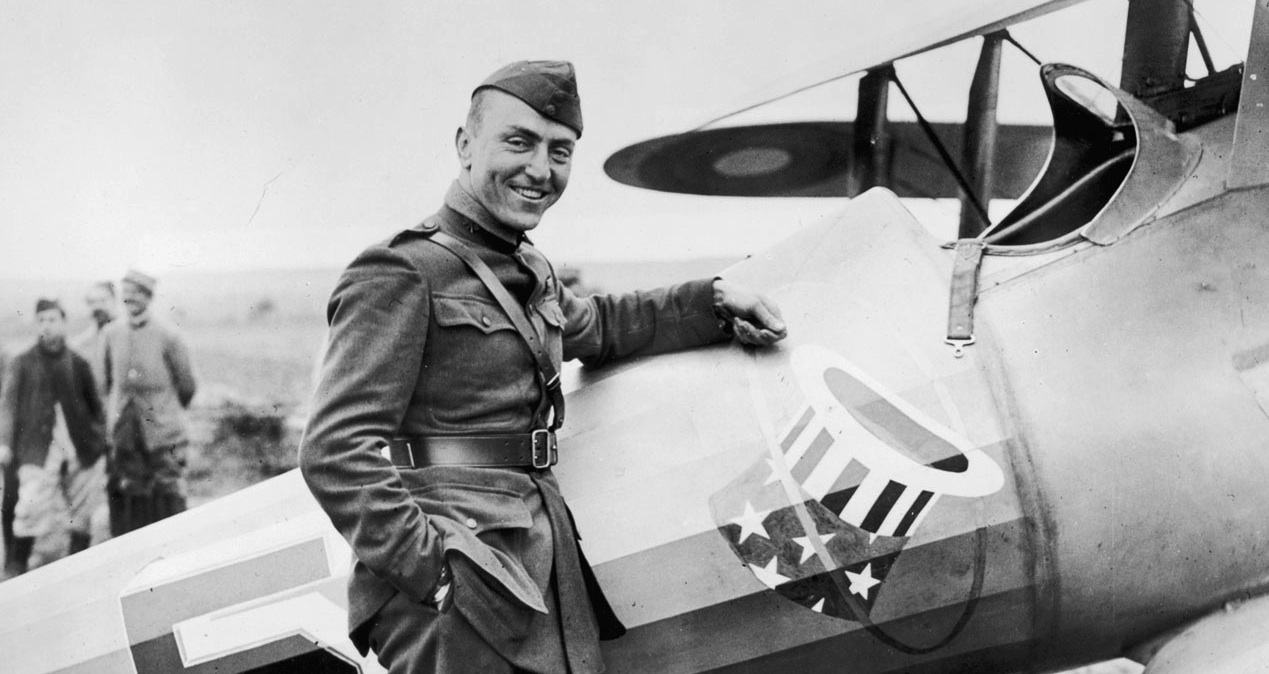TO COMMEMORATE the fourth of July this year, we bring you the story behind Lt. Wilbert Wallace White’s final flight. White was a flight commander with the 147th Aero Squadron, part of the 1st Pursuit Group, First United States Army. The squadron was assigned as a Day Pursuit (Fighter) Squadron and White was the leader of C Flight. At 30, White was the oldest pilot at the 147th and the only one who was married with children. He was to be reassigned stateside, but set off on one final flight before he was to leave—sadly, it was a flight from which he didn’t return. If this sounds familiar, it’s because this same story was featured several months earlier on Frederick Blakeslee’s cover for the January 1932 issue of Battle Aces and the following year as the July 1933 cover of Flying Aces as imagined by Paul Bissell. From the pages of the June 1932 issue of War Aces, it’s Lt. White’s “Last Flight” as told by Capt. Eddie Rickenbacker, Col. Harold Hartley and our own, Lt. O.B. Myers!
More than thirteen years have passed since Lieutenant Wilbert White gave his life for a friend. His body lies buried in France, but the broken joystick with which he drove his Spad head-on into a German Fokker rests on a mantel in the fatherless home of his widow and two children in New York City.
A daughter, now sixteen, and a son, fourteen, treasure the joystick, along with other splintered parts of the wrecked Spad, salvaged from the bank of the Meuse by Lieutenant White’s father, The Reverend Dr. W.W. White, of the Biblical Seminary in New York. The children are both in private schools now and their mother is engaged in scientific research for which she prepared after her husband’s death.
LAST FLIGHT
WITH A REPRIEVE FROM DEATH IN HIS POCKET, LIEUT. WHITE GAVE HIS LIFE THAT A COMRADE MIGHT LIVE
THE TRUE STORY OF ONE OF THE WAR’S GREATEST HEROES
as told by Eddie Rickenbacker, O.B. Myers and Harold Hartney
to James Martindale • War Aces, June 1932

LIEUT. WILBERT WALLACE WHITE
147th Aero Squadron
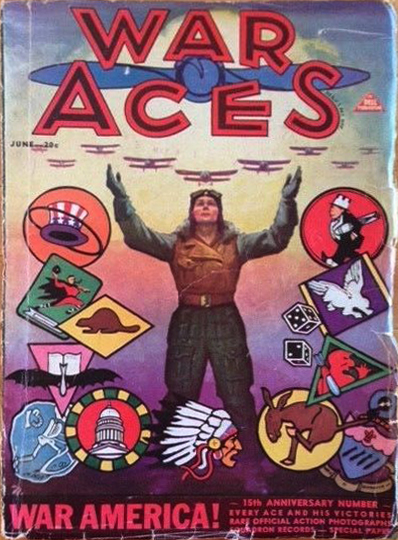 THIS is the story of Lieutenant Wilbert White, of the 147th Pursuit Squadron. It is the story of his last flight. Whitey died on the last flight—he dove head-on into a Fokker to save the life of a youngster whom he had promised to protect on the youth’s first flight over the lines.
THIS is the story of Lieutenant Wilbert White, of the 147th Pursuit Squadron. It is the story of his last flight. Whitey died on the last flight—he dove head-on into a Fokker to save the life of a youngster whom he had promised to protect on the youth’s first flight over the lines.
Eddie Rickenbacker, diving from above to join him, saw him die. The picture still haunts him, and he remembers Whitey as “the bravest man of the war.” Reed Chambers saw it, Jimmy Meissner and a half dozen others, but not one of them can talk of it without tears filling his eyes.
The War Department lists Lieutenant Wilbert W. White as “killed in action,” and on the records at Washington is a second citation, bestowing an oak leaf cluster for a previously awarded Distinguished Service Cross. The citation says:
“In command of a patrol of four planes which was attacked by a large flight of German Fokkers, Lieutenant White attacked the enemy plane which was hard pressing a new pilot. The German Fokker had gotten at the tail of the American plane and was overtaking it. Lieutenant White’s guns having jammed, he drove his plane head-on into the Fokker, both crashing to earth 500 meters below.”
There are similar citations in the archives of the British and French War Offices. But none of them tell, as do the words of Rickenbacker, Colonel Harry Hartney and others who know, the real facts behind that last flight, the facts which make Whitey’s death one of the greatest sacrifices of the war.
Why did he do it?
Rickenbacker answers, “If you had known Whitey as we knew him you would understand.”
In the first place Whitey was a minister’s son and when he enlisted, killing Huns became his religion. War was no game to him—it was a war between right and wrong, and with God and right on the side of the Allies Whitey regarded his guns as weapons of the Lord. Strangely, for all of his six feet or more of bone and muscle and the tinge of red in his hair, he had little use for violence. In the recollection of his pals, he used his fists only once, and on that occasion—an excellent portrayal of his character—to strike a bunkmate for ridiculing a young cadet flyer on his knees in prayer.
In the second place, and this fact probably had a lot to do with his actions, Whitey was thirty years old, an old man in the eyes of his companions just out of their ‘teens. He was the oldest man in the squadron and its only married man. He left a wife and two small children to make the world a safe place to live in and when he reached the Front he immediately wrote his minister-father that at last he felt he had “something to live for, and, if necessary, to die for.”
Whitey died October 10, 1918, while the 147th, a unit of Colonel Hartney’s First Pursuit Group that included Rickenbacker and his famous 94th, was stationed at Rembercourt behind Verdun. Dawn of that same morning found Whitey, already a wearer of the Distinguished Service Cross and the leader of 147’s C Flight, in the midst of an attack on a German observation plane over the lines.
THE stream of lead from Whitey’s Vickers was ripping up the tail of the slow-moving Halberstadt. Another burst from the diving Spad and the German gunner slumped in his cockpit. An incendiary found its way into the Halberstadt’s gas tank and the Hun burst into flames.
The American victor straightened out as the flaming mass crashed into the ridges behind Montfaucon, and with a beckoning wave of the hand reformed with his four companions. A flip of the tail of his Spad and the early morning patrol of C Flight turned for home and breakfast. It was Whitey’s seventh Hun. He signed the combat report with a sense of satisfaction, as of a duty well done, and with the rest of his flight—Ken Porter, O.B. Myers, Billy Brotherton and Pat Herron—trekked down the muddy road from the hangars to the mess hut. There usually, Whitey shared doughnuts and coffee with Rick and Jimmy Meissner, his own commander in the 147th; but this morning Rick and Jimmy were in conference with Colonel Hartney at Group Headquarters. Captain “Ack” Grant of the 27th and Johnny Mitchell of the 95th were there too, for the group commander had called in all four of his squadron leaders.
“I don’t get the idea of the job, colonel,” Rickenbacker was objecting. “And why Whitey?”
“It’s this way, Rick,” Hartney answered. “General Kenly wants an accredited ace to serve on the staff of the Chief of Air Service in Washington. He Wants an inspirational type, a man who can stand as a model to younger men; he wants to send him over the country making speeches, to stir up a little patriotism, I guess. Of course, he will serve in a technical advisory capacity as well.”
“But why do they have to take White?” persisted Rickenbacker. “That crowd of generals-”
“I know, Rick,” Hartney temporized. “You can’t deny though—Whitey fits the bill.”
“He’ll never do it,” broke in Meissner.
“He’ll have to,” responded the commander. “The orders came through from General Patrick at Tours this morning.” Hartney hesitated a moment, then added, “You’re forgetting, fellows, Whitey has a wife and two kids back there. That’s not the reason he’s going back, but his wife probably will be glad even if we are reluctant to lose him.”
“She won’t if she’s anything like Whitey,” interjected the 94th’s leader. “You’ll have a swell time convincing Whitey that that’s not the reason he was picked, and I for one don’t want to be here when you tell him. Is there anything else, colonel?”
Hartney shook his head. The four squadron commanders filed out, and after them went Captain Cunningham, operations officer, to summon Whitey to headquarters. The pilot returned with him and found Hartney standing beside bis desk, tapping a pencil.
“Whitey,” he began. “I’ve some good news for you—”
“Yes, I know, colonel, Meissner told me. Young Charley Cox is coming up with us. I’m glad, colonel.” Then more seriously he added, “You see, I sort of feel it a duty to take care of that kid. I knew him you know, and his father and mother. That’s why I asked you to help me in getting him here with us. I just got a letter from his dad this morning.”
Hartney’s face clouded; he walked behind his desk.
“Yes, Whitey,” he said. “Cox will be up sometime to-day, and he’ll be assigned to the 147th. But that’s not what I called you over for.” The commander hesitated as a look of doubt spread over the pilot’s browned and wind-burned face. “It’s this, Whitey—there’s no use trying to put it in softer words—General Patrick has ordered you back to the States for special duty on the staff of General Kenly, Chief of the Air Service at Washington.”
THE orders left the younger man speechless. The amazed, hurt look in his eyes caused Hartney to turn away and to finish his order in short, staccato sentences.
“Your new duties will be varied—advisory work partly and other special stuff. You can take my word for it you weren’t picked at random. You were chosen because of your excellent record. It’s an important job. I’m sorry, more sorry than I can say, to lose you. We all are, but it comes from above me, and I haven’t anything to say about it.”
Hartney tried to end it there. It wasn’t easy, nor pleasant, ordering a fellow like Whitey back to the States; ordering anyone, for that matter, from that reckless crowd of fighting youths. He couldn’t refuse to listen as the amazed flyer regained his tongue.
“I—I don’t understand, colonel.” The good-natured smile was gone now. In its place was a look of doubt, as if he questioned the truth of Hartney’s explanation.
“I can’t leave, colonel—not now anyway. You’re sure” —he spoke more quickly as the thought occurred to him— “You’re sure the fact that I have a family has nothing to do with it? ”
There was only one way for Hartney to deal with the situation. That was to be brusque. As difficult as that was, Hartney spoke sharply.
“I can’t help it, White. Orders are orders. Here they are.” He handed over a sealed envelope. “They date from to-morrow. Better get packed up. The boys, I understand, want to throw a little party for you to-night, and you can leave early in the morning for Paris.”
Hartney turned away, indicating dismissal, but as the bewildered pilot walked slowly toward the entrance of the hut there came one more command from his senior officer.
“Just one more thing, Whitey. I’ve instructed Meissner to take you off the regular patrols for the rest of the day. I—I’d stay on the ground if I were you. That’s all. I’ll see you again before you leave for Paris.”
Whitey did not answer. He walked out slowly, the sealed orders in his hand unopened, and wandered unseeing in a circuitous journey that finally led him to 147’s barracks across the Sacra Via that ran from Rembercourt to Verdun.
He was sitting on his cot, staring at the floor, when Ken Porter and “Obie” Myers, his companions of the morning patrol, found him. They walked up quietly, and both cleared their throats significantly before they uttered a word. Porter spoke first.
“What’s the use of our trying to say anything, Whitey? It’s a lousy trick to play on any man, especially you.”
Whitey seemed not to hear. He sat unmoved, his head pressed tightly between his hands, his elbows on his knees. Porter continued.
“There is this about it, though, old fellow. You’ve got to think of the wife and kids. You’re the oldest man in the squadron, you know, and the only one with a family. This suicide club is no place for a fellow like you; it doesn’t matter about the rest of us bums.”
The mention of the word “family” brought the first response from the flight leader.
“That’s just it, Ken.” He dropped his hands from his head. “If I thought—if I thought for one minute that that was the only reason, I’d never go back.” The flash of anger faded then, and more soberly he continued, “It isn’t that I don’t care about my family—God knows I do. It’s just that this is my duty; this is what I’m trained for, this is something that I can do to help. Why, then, why should they keep me from doing it?”
Porter, the youngster of the 147th, whose youthfulness had won him the fatherly protection of the older man, had no answer, and with Myers stood glumly silent as their flight leader searched his mind for some answer, some explanation. Suddenly Whitey leaped to his feet. The set of his jaw startled his two listeners.
“Listen to me, you two!” Whitey’s voice rose almost to a shout. “Orders are orders, Hartney said. All right, there’s no way out that I can see. But if I’ve got to go back, I’m going to finish up my job here first. I’ve got seven Huns now, haven’t I? Alright, I’m not going back without another crack at them, and you two have got to help me?”
Myers spoke now for the first time. There was a pleading note in his voice.
“But Whitey, don’t be a damned fool.
You’ve got your orders in your pocket. 
You’re alive now, you’re all whole. 
Stay that way. You’re only asking for 
it if you—”
“Are you going to help me or do I have to go out alone? ” demanded Whitey.
There was only one answer when Whitey spoke like that. And Porter and Myers knew that if they didn’t go along to help and protect this Hun hater, that he would go alone, and that he probably wouldn’t come back alive. They promised, although reluctantly.
“Fine,” Whitey responded, his spirits reviving. “We’ll do a reconnaissance patrol. Meissner won’t keep me down. I’ll notify him and we’ll meet at the hangar in twenty minutes.”
MEISSNER argued for fifteen of those twenty minutes before he gave up trying to dissuade his flight leader from going’aloft. Rickenbacker, too, pleaded. It was all to no avail.
“You’d feel the same way, Rick, in my place.”
“Yeah? I’d stay right on the ground!”
“No you wouldn’t,” and Whitey smiled and walked away.
There was, of course, Hartney. Hartney could have stopped him with an authoritative command had he known. But who was there in all that group who would have cheated the pilot of his wish? He had said, had insisted, that he’d rather die than go back without one more journey over the lines, and there was in the refusal of his fellows to notify the commander almost the resignation of allowing a dying man his last wish. No, Whitey could go if he must; putting themselves in his place they all felt they probably would have wanted to do the same thing. Nevertheless they all watched his take-off with dubious shakes of their heads.
The trio of Spads, Porter on the left and Myers on the right of their flight leader, cleared the wooded slopes at the north end of the muddy field and followed the ravine toward Dun-sur-Meuse. Over Montfaucon again, and the hill that had been the quarters of the German Crown Prince before the Americans broke the Hindenburg Line, and the woods where only the week before Whittlesey and his famous “Lost Battalion” had stood off the surrounding Huns for five days.
Whitey led his companions on a steep climb over Bantheville as they flew into enemy territory. Above and below him the sky was clear of the enemy, as far as the eye could penetrate the mist and fog. Where were they? Why didn’t they come out and fight, the rats! Didn’t they know this was his last day at the Front?
He fondled the triggers on his joystick. It was almost a caress. The States! What was the “special duty?” Why? What for? Even thinking of it was enough to drive a man mad! And why, of the whole lot, did he have to draw the assignment? Whitey could have unleashed a few bursts of his Vickers just to relieve his pent-up anger.
Behind him, to the left and right, flew Ken and Obie, their minds also burdened with their thoughts, too burdened and preoccupied in fact for the safety of the tiny flight of Spads.
It was Ken, not Whitey whose eye and sense of the enemy’s presence usually was so keen, who first saw the Fokkers; and even he did not see them until the red-nosed biplanes were well into their dive out of the protective rays of the sun that was poking its way through the clouds. Ken grabbed his triggers, gave one short burst as a signal of warning to Whitey and Obie and sideslipped away from the dive of one Fokker and caught a quick burst at a second Hun that swept across his bow.
They were seven, the Fokkers, Stenay Fokkers from the late Baron’s own circus and they dove through the trio of Spads with their twin Spandaus spurting flame.
Whitey turned at Ken’s warning burst. Damn! Caught asleep! He jerked at his stick and strained his Spad into a roll that saved him from the opening fire of the Hun leader. He saw two of the enemy tearing at Obie and two others at Ken as he climbed with the Fokker leader on his tail.
Spandau tracer was licking at his tail. His motor! Hit! It was missing. He rolled over instinctively as the whizzing bullets reached out for his cockpit. Something was wrong with him—he couldn’t shake this Hun. Another burst of Spandau lead. A worthy opponent. It was time to start fighting, if he wanted to live.
WHITEY was climbing now, seeking a cloud, and from it he dove for the Hun. For the moment he had him in line of fire. But no, his guns jammed. Was everything against him to-day? A balky motor—now a jam! Whitey dove for safety as he struggled to repair his weapons.
But escape was not so easy. Not that he wanted escape, but the Hun was on him again now. Lead was streaking over his head. Another roll, another loop? Where was Ken? Obie? He had lost them; no, he had deserted them, deserted the two who had come out to protect him, abandoned them to the mercy of six other Fokkers. Two against six.
Fool! Selfish fool! Whitey’s jaw set. He slapped the obstreperous Vickers, and turned on his opponent with a vengeance that was not to be denied. It was an aroused, red-haired Yankee at the stick of the Spad now, a pilot whose fingers fairly itched at the triggers of his joystick. The old Whitey.
They were some distance apart now, coming at each other head-on. The German triggered first. His bullets were wasted. “The fool,” muttered Whitey. The Vickers were silent. The Hun was getting scared. The rat! He was wavering now, too. “Turn out, you Heinie! Turn out and die!” Whitey held his course, straight for the red nose of the Fokker. It was turn out or die in collision. “Make ‘em turn out,” was Whitey’s motto; “they’ll turn.” And the Fokker’s master turned, turned out to avoid collision and he died in the first burst of Whitey’s deadly aim.
Triumphant, the Spad leader grinned with satisfaction as he watched the Fokker slowly circle into its last spin, its pilot dead at the stick. But the grin faded suddenly with the thought of Ken and Obie. Where were they? Whitey cursed himself, and with a shameful sense of desertion sought for the Spads of his companions. In vain he scanned the sky above and below. He covered the lines with the same result. Fokkers or Spads, there were none to be seen. With a sinking heart he started for home.
He circled the drome twice before landing. His heart leaped as he saw a Spad being pulled into the hangar. But was it Ken’s, or Obie’s? He swept down to a sloppy, dangerous landing on the muddy field.
His first words were to the mechanic who helped him out.
“Porter—Myers! Are they back?”
The mechanic seemed not to hear.
“My God, tell me, you fool! Porter and Myers—did they get back?”
The mechanic looked up.
“Porter? Myers? Oh, yeah, they got back. But there ain’t enough left of their two ships to make one good training crate.”
The mechanic’s lightly given assurance left Whitey weak in the knees. He felt a little sick.
“Thanks,” he mumbled, and with his helmet dangling in his right hand, he stumbled toward barracks, not even waiting to make out a combat report.
He found them drinking coffee. Their cheerful greeting was lost on him. He walked straight up to them, his eyes filling up with tears.
“Ken,” he mumbled, putting his hand on the younger pilot’s shoulder. “Ken, I ought to be shot. And you, Obie, I can’t tell you how I feel. It was rotten, just plain selfishness. I should have been killed; I deserved to be, for running out on you like that. And when the two of you came along just to help me with my silly pride—”
Words failed him then, and he sank down on a bench, his head in his hands. Porter and Myers exchanged glances, and nodded. Porter spoke up first. His words came in pseudo-sarcasm.
“What’s the matter with you, Whitey? Gone haywire or something?” He slapped his flight leader on the back and pushed a cup of black coffee at him.
” Come on now, come out of it. We’re all here, aren’t we? All alive? What the hell does it matter? It wasn’t your fault because the damned Hun leader happened to pick on you. We managed it okey. We just ran around until we saw you were on top, then we tore for home. That’s all there was to it. Forget it!”
The play-acting had its hoped-for effect. Whitey shook his head, uttered another apology and then relaxed with a sigh of relief and drank his coffee with a lighter heart.
“Okay, Ken,” he said finally. “I guess I was a little worked up about it. But I’m sorry, anyway, and that apology goes to you too, Obie.”
“Forget it, Whitey,”responded Myers with a reassuring shove. “Now let’s do a little serious thinking about this party to-night—it’s a farewell party, Whitey, and we ought to make it a good one. This crowd needs a party. There’s been too damned much thinking going on around here.”
“Madame Mourot’s, huh?” suggested Porter.
“Now wait a minute, fellows,” in
terrupted Whitey. “You know, hon
estly, I’d just as soon pack up my stuff
and then sort of drop around quietly 
and shake hands with everybody. This 
dinner and party stuff—”
“Too late, son,” cut in Myers, rising to his feet. “You’re overruled. Mr. Porter and Mr. Myers of the committee on arrangements are already on their way to Erize la Petite to negotiate. So long, Whitey, see you hence.”
THE two pilots left immediately for the village. It was nearly 2:30 when Porter returned alone. He found Whitey in barracks, finishing a letter to his wife telling of his orders home.
“Everything is set, Whitey,” he said and started off for his own bunk, but the other pilot, rising from the floor, called him back.
“What’s the hurry?”
“Got a little work to do, sir,” Porter answered, picking up his flying togs. “Hartney detailed A Flight to stick a balloon over at Dun-sur-Meuse, same one you took a crack at the other day, I think. But A Flight hasn’t any balloon gun in working order, so Billy Brotherton drew the job, and he prefers C Flight men for company.”
“Who’s going?”
“Well, you’re not down.”
“Who’s going, I said,” Whitey repeated.
“Well, Meissner, Pat Herron, myself and this Cox kid that just came up.”
Whitey scowled, more with disbelief than surprise.
“Not Charley Cox, the kid ”
“Well,” responded Porter with a shrug, “he’s down on the list. Meissner said the kid insisted on going along, and that he didn’t have the heart to refuse him.”
Without another word Whitey turned and reached for his own flying clothes. He had started changing before Porter noticed.
“Now what?” Porter demanded.
“I’m going along,” said Whitey, slipping on a heavy shirt.
Porter slammed his heavy gloves to the floor and strode over with his hands on his hips.
“For God’s sake, Whitey! We’ll take care of the kid, if that’s what’s worrying you. You’ve had enough. I thought we settled all that a while ago.”
The older pilot shook his head. “I know, Ken, but—well, I got the kid up here, and I want to see him over the lines for the first time. I promised his people that, and I want to do it, that’s all.”
Ken started to argue but he gave up in exasperation as Whitey calmly finished changing.
“What’s the use of my arguing with you, Whitey? All I hope is that Meissner or Hartney keeps you on the ground. I can’t,” and he strode out of barracks.
But Meissner’s argument was no more successful than it had been earlier in the morning, and when three o’clock came around Whitey was ready to lead his flight. He greeted Cox for the first time out on the field, took him aside for a brief chat and a bit of advice and then returned to the corner of the hangar where he waited with Porter and Brotherton while mechanics warmed up their Spads.
The assignment was more extensive than Porter had described. It called for simultaneous attacks on two balloons, the one at Dun-sur-Meuse and another near Bantheville. Brotherton, C Flight’s balloon strafer, was to stick the balloon at Dun-sur-Meuse under Whitey’s protecting flight; Reed Chambers, guarded by another flight, was to tackle the other bag while his teammate, Rickenbacker, with a flight from the 94th, was detailed to cover both flights from above and rendezvous with them over the line at four o’clock.
Porter and Brotherton chafed impatiently as the Spads warmed up, but Whitey was silent. He leaned against the corner of the hangar, drawing slowly and deeply of his cigarette, his eyes scanning the clouds above. His thoughts seemed far away. Not until the signal from the mechanics came did he speak, and then it was only a parting word of instruction to Porter.
“My adieu to the Huns, Ken,” he said. “I’m glad you’re along. Keep an eye on the kid, keep him in close.”
They parted on the line, the three of them, but the flight leader was the last to climb into his ship. First, he walked clear around the plane, surveyed each patched spot on wing and tail, each nicked strut or repaired brace. He came around to the side of the cockpit and was ready to climb in when Rickenbacker came up.
“Whitey, for God’s sake listen—”
“It’s okay, Rick, this is the last trip. We’d better get going.”
The 94th’s leader was reluctant to leave. Whitey climbed in the cockpit smiling and reached up for Rick’s hand.
“All right, Whitey. Lots of luck. I’ll be upstairs looking out for you.”
“Thanks, Rick.”
The five Hispanos of C Flight roared in unison. Whitey took off first from the emergency sod runway laid on top the soggy field. Cox followed, then Herron, Porter, Meissner and Brotherton, but Porter’s Spad faltered as it was clearing the trees at the edge of the field and he barely made it back to the drome with the high-speed jet on his left bank of cylinders clogged by an aluminum shaving.
ALOFT the five Spads moved into formation with Brotherton underneath as the grounded Porter climbed into another ship to rejoin them. But they waited in vain, for as Porter sent his new mount over the soggy runway a clod of mud splintered his prop and both Spad and pilot landed nose up “in the soup.” Whitey gave the signal now to move on, but he gave it reluctantly. He wanted Ken along this last trip, might need him; somehow it was comforting to know that Porter was back there on his left. Ken could catch up, though, maybe, before they hit the lines. But Ken never caught up—an overheated motor turned him back for the third and last time as his companions passed out of sight.
They crossed the lines and pointed for Dun-sur-Meuse with the sun over their left shoulders. Brotherton flew at about four hundred meters, ready to snag the balloon with his 11-millimeter guns. Six or seven hundred higher, and slightly back, came the others, Whitey leading with his newly arrived protege in the rear between Meissner and Herron.
The air was fairly clear of the enemy as they went in, but the Huns were not idle; even as the flight of Spads crossed the lines eleven Fokkers were moving in from Stenay behind the youthful Lieutenant Pfaffenritter who carried in his pocket a leave that was to take him home to Berlin that night for a visit.
Rickenbacker, wide of his own flight, saw them first, and he tackled the rear of their formation as they swung out of the rays of the protecting sun.
Whitey saw them, ahead and above. He turned toward them, the best tactical move to cover up Billy down below. For a moment nothing happened. It looked as if there was to be no scrap, except that single duel which had taken the rearmost German and Rickenbacker a mile to the west. Then Brotherton, his heavy balloon guns spitting out their streams of incendiaries, dove through the rain of Jerry fire for the descending bag below. His attack was the signal for the attack of the Fokkers.
The watchful Spad leader turned again to meet them but the red-nosed Fokkers swerved for the rear of the Spad formation and, avoiding its leader, swarmed over Meissner, Herron and Cox with the German leader singling out the inexperienced Cox for his victim.
Whitey looked over his shoulder. Meissner was deftly rolling out of the path of one German; Herron, both guns blazing was tangling with two of the enemy. Whitey challenged one of them, and avoiding his opponent’s initial swoop, turned to meet him at closer quarters.
The German was too hasty. His Spandaus were blazing wildly. Whitey grinned confidently, withholding his own fire. His Spad strained and bent as he twisted and came out of a roll on the Hun’s tail. Whitey gripped his triggers, ready for the kill. A short burst of Vickers tracer caught the Fokker cockpit; another burst now and it would be over. But the Vickers jammed! Whitey cursed as he fought with the stubborn gun.
A Spad screamed past overhead. It was Cox, and on his tail was the Fokker leader with both guns spitting flame.
Whitey forgot his jammed guns; he forgot his own opponent and allowed him to slip away to safety. He came about on a wing-tip, his eyes glued on the red-nosed plane that was dropping into deadly position on Charley Cox’s rudder. Spandau lead was eating up the fuselage of Cox’s Spad. It was a matter of split seconds now and Cox would be gone. Whitey tore in head-on, his Spad with its useless guns pointed straight for the Fokker leader.
The move succeeded. The breathless Cox, so close to death an instant before, climbed to safety as the Hun leader turned to meet the onrush of his new enemy. Twice his Spandaus barked out. The Vickers of Whitey’s Spad were silent but the bulletlike directness of his drive never varied. Head-on they
raced, Whitey and the youthful German.
Rickenbacker, tearing in from victory over his opponent, saw it. Reed Chambers, fleeing from his successful attack on the other balloon, saw it. They watched with bated breath. They could almost hear the Spad leader’s chant, “Never turn out for a Hun—make him turn out!” Whitey was holding his fire, they thought, for the German to turn out. But the Hun never wavered; nor did Whitey. Two of a kind, they were—the same methods of combat, equally matched in nerve and skill, except that Whitey’s guns were useless. A brave determined Yankee, a brave determined German. Turn out and die. Neither turned out. Both died.
THE Spad and Fokker struck head-on. There wasn’t much of a crash. Their wings just seemed to melt together, and they locked in one crazy tangle. There was no fire; no smoke. It was just a floundering mass of splintered wood and fabric that fell swiftly down and down. A few splinters of wood, a few shreds of canvas fluttered around as if lost. That was all.
Somehow there was no combat after that. Not a trigger was pressed from the moment that Whitey swept into that headlong drive to force the Hun from his protege’s rudder. The stark tragedy of it all took everybody by the throat, Boche and Yankee alike. Two brave men had gone to their end in that brief moment that had encompassed one of the most supreme sacrifices of the war. No taste for fighting remained, and the leaderless formations of Spads and Fokkers turned for home.
Rickenbacker was the first to reach Hartney’s office with the news. He staggered into the headquarters hut, his eyes blinded by tears.
“Whitey—” he mumbled, and sank weakly into a chair. It was several minutes before he found his voice.
“A Hun got on young Cox’s tail— Whitey went to his rescue—his guns jammed and he drove head-on into the Hun. They fell together just east of the river. I tried—I tried to get down, but too late.”
Hartney swallowed hard and walking to the pilot’s side, shook him roughly.
“Brace up, Rick. Get yourself a drink.”
“I—I can’t, colonel, I’m sick,” and Rickenbacker staggered out the doorway.
Meissner came in next; then Chambers and all the rest except young Billy Brotherton who never came out of his dive on the balloon. Young Cox, whose life had been spared by Whitey’s sacrifice, couldn’t tell his story until the next day. And he told it while virtually every patrol sought through low, dangerous flying, to find where Whitey had fallen. They hunted for days but not until next April, months after the Armistice, was the search successful.
Reed Chambers, who remained in command of the 94th after Rickenbacker returned to the States, found the body on the east bank of the Meuse near Dun. With Whitey’s father and two members of the Graves Registration Department, he searched for three days along the bank where he had seen the interlocked Spad and Fokker crash. A shred of Spad fabric, caught on the remains of a stretch of barbed wire, led him to a spot where beneath a shallow layer of earth the heroic American pilot had been hastily buried by villagers. Not far away was another grave bearing only the marking, “An Unidentified German Aviator.”
Ironically, the two bodies were identified by papers found in the pockets of their uniforms, and the papers in both instances were orders for home—for Whitey, his orders back to the States; for Lieutenant Pfaffenritter his leave for a visit with his mother in Berlin.

The 147th Aero Squadron They are, standing, from left to right, 1Lt Oscar B Meyers, 2Lt Arthur H Jones, 2Lt Edward H Clouser (adjutant), 2Lt Ralph A O’Neill (five victories), ILt James A Healy (five victories), 2Lt Charles P Porter, Maj Harold E Hartney, commander 1st Pursuit Group (seven victories), Capt James A Meissner, commander 147th Aero Squadron (eight victories), 1Lt Heywood E Cutting, 1Lt James P Herron, 2Lt Francis M Simonds (five victories), 1Lt George H Brew, 2Lt G Gale Willard, 2Lt Cleveland W McDermott and 1Lt Collier C Olive. Squatting, from left to right, ILt Walter P Muther, 2Lt Frank C Ennis, 2Lt Louis C Simon Jr, 1Lt G A S Robertson, 2Lt Stuart T Purcell, 2Lt Thomas J Abernethy, 1Lt Horace A Anderson (supply officer), 1Lt Josiah P Rowe Jr, 2Lt James C McEvoy and 2Lt John W Havey (armament officer)

AS A bonus, we present “Lieutenant White’s Supreme Sacrifice”—The story behind the cover of Paul Bissell’s July 1933 cover for Flying Aces! Bissell is mainly known for doing the covers of Flying Aces from 1931 through 1934 when C.B. Mayshark took over duties. For the July 1933 cover Bissell recreates Lt. White’s headlong dive into a German plane to save a young pilot he was looking out for on his squadron—The spectacular crash captured in a freeze-frame. The story behind it is Lt. Reed Chamber’s account of events.
Lieutenant White’s Supreme Sacrifice
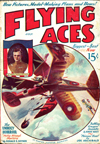 “SO THIS was the stick he used to guide his plane! It’s hard to realize that my boy’s live hands once held it as I hold it now.” And the man dressed in clerical garb revolved the broken joystick slowly in his hand as he turned sadly to the young lieutenant with him.
“SO THIS was the stick he used to guide his plane! It’s hard to realize that my boy’s live hands once held it as I hold it now.” And the man dressed in clerical garb revolved the broken joystick slowly in his hand as he turned sadly to the young lieutenant with him.
The speaker was Dr. W.W. White of the Biblical Seminary in New York. He had come to France to search for the body of his son, Lieutenant Wilbert Wallace White of the 147th Squadron who, on October the tenth, 1918, in one of the most dramatic sacrifices of the war, had crashed head on with an enemy ship high above the lines. The Doctor’s companion was Lieutenant Reed Chambers, American ace, who had taken charge of the 94th Squadron when Captain Rickenbacker had returned to America.
Now, six months after Lieutenant White’s death, these two sat in a little pension near the village of Dun on the banks of the Meuse. For three days they had searched up and down the banks of the river for some sign of the wrecked ship which Reed Chambers himself had seen fall, twisted and tangled with the German plane.
Only this afternoon had their search been rewarded by their finding the scant remains of the wrecked planes half-buried in the muddy banks of the Meuse. From peasants in the neighborhood they learned that the two aviators had been buried in a near-by field, and, in the morning, with two members of the Grave Registration Department present, the bodies were to be disinterred for identification.
“I’m sure it is his stick, sir,” Chambers answered, “and to me, too, it hardly seems possible that that useless bit of wood still remains much as it was, while Whitey, with all that he could and would have done, is no longer with us.
“You see,” he continued, “that’s where you who have faith have it over the rest of us. To you, it is all a part of some plan, even if you don’t understand it completely. We at the Front soon became fatalistic, feeling, as the French would say, ’C’est la guerre,’ or else we feel like blaming some one in some way or other for it all.â€
“Certainly there is no one to blame in this case,” the older man replied.
“No, I don’t think there is, really, but we all felt a little bit to blame, sir. Perhaps particularly Colonel Hartney and Jimmy Meissner. Either of them could have ordered Whitey to stay on the ground, but you know how he was. To begin with, when first he heard of the orders sending him back home, he was stunned and angry. He knew that all of you back there felt as he did, that he belonged here where he was best able to serve. He resented what appeared as perhaps a choice, granting him safety and life, while other chaps were sent out to be bumped off.”
“Yes, I can understand that,” replied White’s father.
“God knows he had already done his duty,” said Chambers. “He had seven Germans to his credit already, and had been in a hundred scraps. That was what we all tried to get over to him—that he had done his bit here, and that real work was awaiting him back in Washington. It took a lot of talking, but he was convinced at last, and keen on getting back to see all of you. He had no intention of making that last flight. It wasn’t a foolhardy gesture, I’m sure of that, sir. But you know, he was somewhat older than a lot of the kids that came up and he liked to look after them, not only in the air, but on the ground.
“And, you see, he had looked forward to Cox’s coming. In fact, he had helped get Cox assigned to the 147th. Only that morning he had heard from the boy’s parents, and so, when he learned that Cox had been assigned to immediate patrol, he wanted to go over with the youngster on his first flight.
“YOU, too, were on the patrol, were you not?” asked the Doctor.
“Yes,” replied Chambers. “I had a crack at a balloon just below here at Bantheville. Whitey, with Meissner, Pat Herron, Cox, and Porter were to keep the Germans off Brotherton’s tail, while he went at a sausage just above this village here. Rickenbacker, with a flight from the 94th, was upstairs, keeping an eye on both of us. Ken—that’s Porter, you know—didn’t finally fly the patrol at all. Three engines went bad on him in succession. “So, after waiting a short time for him to join the formation, we all headed over in this direction, Whitey leading his flight, with Brotherton below and Meissner and Herron behind, riding their planes on either side of Cox.
“As we came over the lines, things were pretty clear, but just as we got a short distance from here, eleven Heinies came flying in from Stenay. This bunch was part of Richthofen’s old crowd, you know. Whitey turned to meet them, which was the only thing to do in order to cover up Brotherton below, who was then all set and ready for his dive on the balloon.
“The Germans did not attack at once, though Rickenbacker up above slipped in on the rear of their formation and after a short scrap got the last one of the crowd. Just then Brotherton dived on the balloon and, as if this were a signal, the whole flight of Germans dropped on Whitey and his crowd. I was pretty busy over Bantheville at this minute, but Jimmy tells me that the Jerries swung off, avoiding Whitey’s head on attack, then turned quickly and came at them from behind, the German leader apparently singling out Cox for his victim.
“Jimmy and Herron both had their hands full, what with the enemy outnumbering them about three to one, and Cox got separated from them. Whitey, it seems, turned and had just rolled himself into a swell position on one of the German’s tails when his guns jammed. I guess that’s what did the trick, sir.
“Having his guns jammed was no new experience for Whitey, and ordinarily, even against the odds, he could have slipped out of the fight, fixed his guns, and been back at it in a minute. But just when his guns jammed, he caught sight of Cox, tipped up on one wing, heading toward him, striving desperately to get away from the red-nosed machine on his tail.
“The kid was putting up a swell fight, but he was up against old hands at the game, and the odds were against him. Whitey had no time to clear his guns now. In another moment it would be all over. No one knew that better than Whitey, and as quick as a flash he had left his own German and was diving headlong at Cox’s opponent.
“Maybe he forgot his guns were Jammed. Maybe he thought the German would turn out. He used to say, ‘Never turn out for a Hun. Make him do the turning out.’ But if you ask me, I don’t think it was that either, he was responsible for the kid, and the kid must be saved, let the cost be what it would. And there was only be way, since his guns were jammed, and that was to make the German turn.
“Well, I had finished my job and was just heading back, trying to get into the scrap, when I saw Whitey go for the red machine. I didn’t know his guns were jammed. I thought he was holding his fire, holding it till the Jerry turned out and he could give him a burst.”
Chambers looked up at the older man, who stared fixedly at the broken stick in his hands. Then the lieutenant rose to his feet and, putting his hand on his companion’s shoulder, continued.
“Well, the German didn’t turn out, sir. And this I’m sure of—if it had to be done over, there would be no hesitation on Whitey’s part, and he would again crash any German that ever flew if that was necessary to save a comrade in trouble.”
NEXT morning the sun shone down from a clear April sky. A soft spring breeze stirred the new-sprung blades of grass in the small field just at the river’s edge. To the right a row of tall poplars lined a road that wound over a hill to the small village beyond, hidden except for the thrust of its church spire, above the trees.
In the corner of the field the earth had been thrown back from two shallow graves, and here a small group of men were gathered.
“There can be no doubt about it, sir. These are the orders we found in his pocket. You can see that they are papers ordering Lieutenant Wilbert Wallace White to return to Washington for special duty on the staff of General Kenly, Chief of Air Service.”
There was a hush as the elderly civilian, taking the crumpled and worn papers from the officer, read them through slowly and carefully. In the distance the soft peal of the church bells could be heard.
“Yes,” he said, finally, “I am sure there is no question about it. It is my boy. And what of the other lad?”
“His name was Pfaffenritter,” they answered. “We identified him also by his orders.”
But they did not go on to say that this lad, too, held in his pocket a reprieve from death. On the following morning he was to have gone on leave to Berlin to see his mother.

“Lieutenant White’s Supreme Sacrifice”
Flying Aces, July 1933 by Paul Bissell
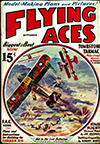 THE Congressional Medal of Honor is the highest decoration the United States can bestow upon its military heroes. Only four airmen of the World War received it — Captain Edward V. Rickenbacker, Lieutenant Frank Luke, and Lieutenants Harold Ernest Goettler and Erwin R. Bleckley. The first two, both aces, are well known, and most people know that Congress so honored them, even if a bit tardily in Rickenbacker’s case. But few know of Goettler and Bleckley and the glorious story of how they gave their lives, going “above and beyond the call of duty in action with the enemy†in an effort to save some of their countrymen.
THE Congressional Medal of Honor is the highest decoration the United States can bestow upon its military heroes. Only four airmen of the World War received it — Captain Edward V. Rickenbacker, Lieutenant Frank Luke, and Lieutenants Harold Ernest Goettler and Erwin R. Bleckley. The first two, both aces, are well known, and most people know that Congress so honored them, even if a bit tardily in Rickenbacker’s case. But few know of Goettler and Bleckley and the glorious story of how they gave their lives, going “above and beyond the call of duty in action with the enemy†in an effort to save some of their countrymen.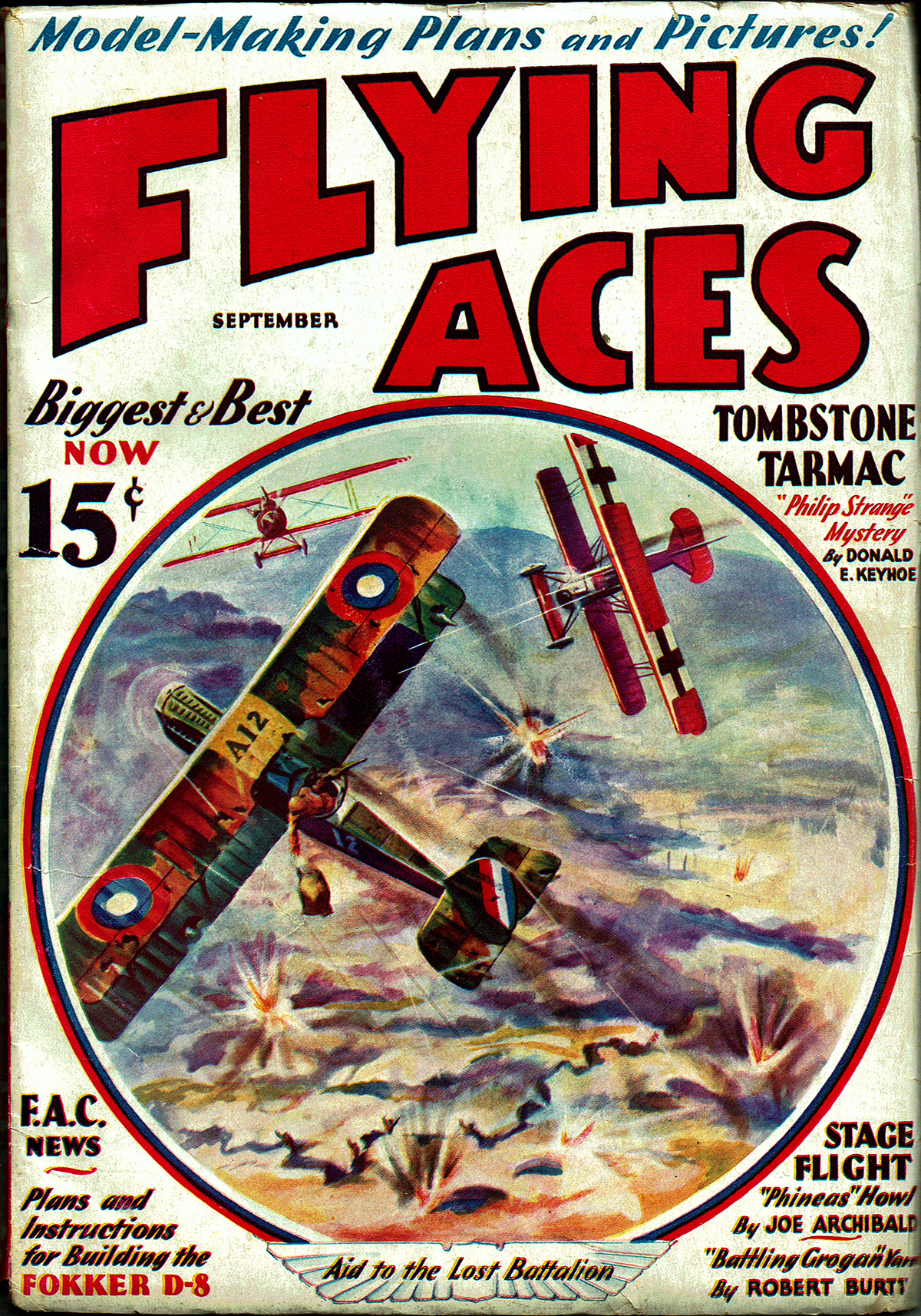





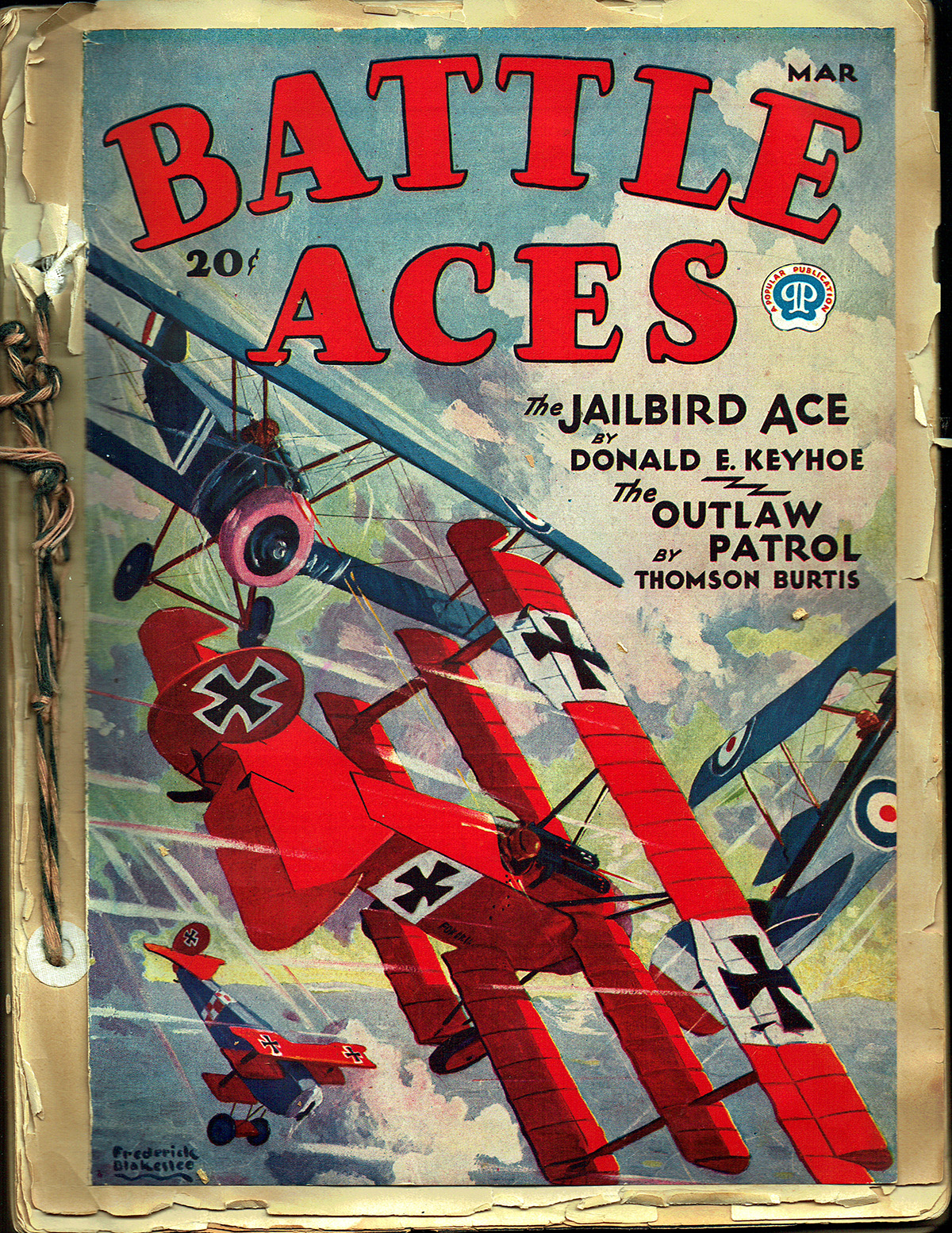 Like many in the late 20’s and early 30’s, Robert O’Neil was fascinated with aviation and not just the planes, but also some of the men who made a name for themselves flying them in The Great War.
Like many in the late 20’s and early 30’s, Robert O’Neil was fascinated with aviation and not just the planes, but also some of the men who made a name for themselves flying them in The Great War.
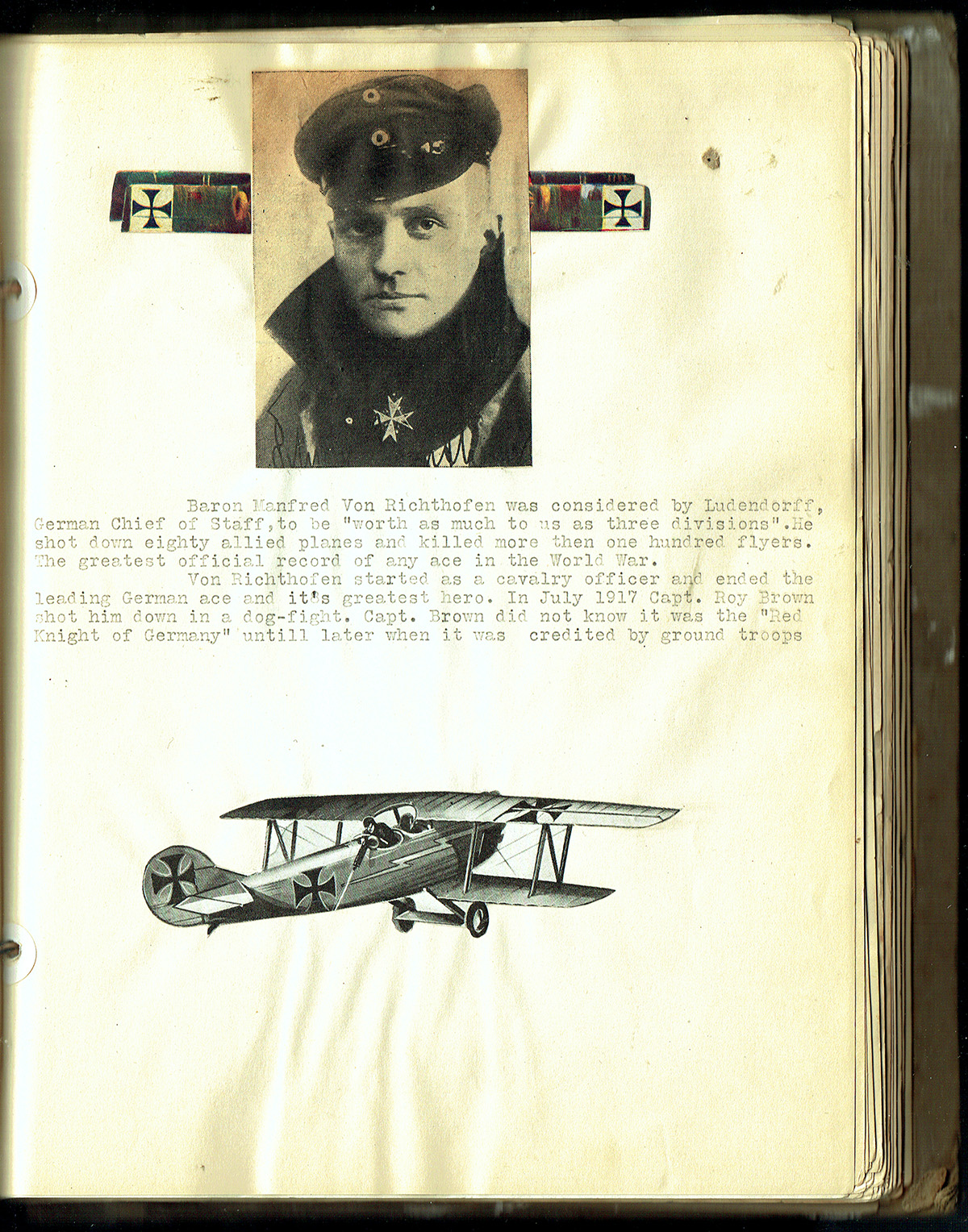
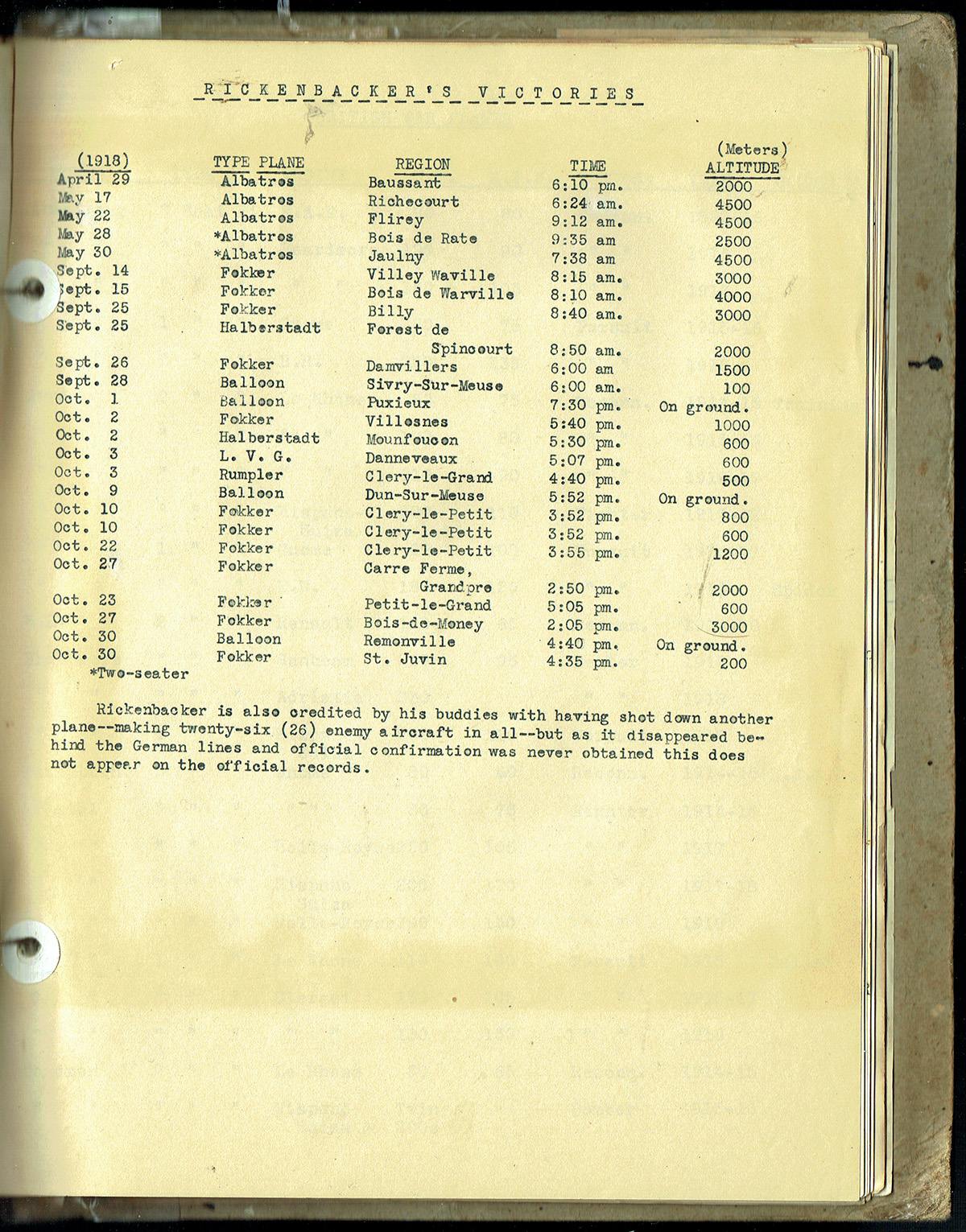
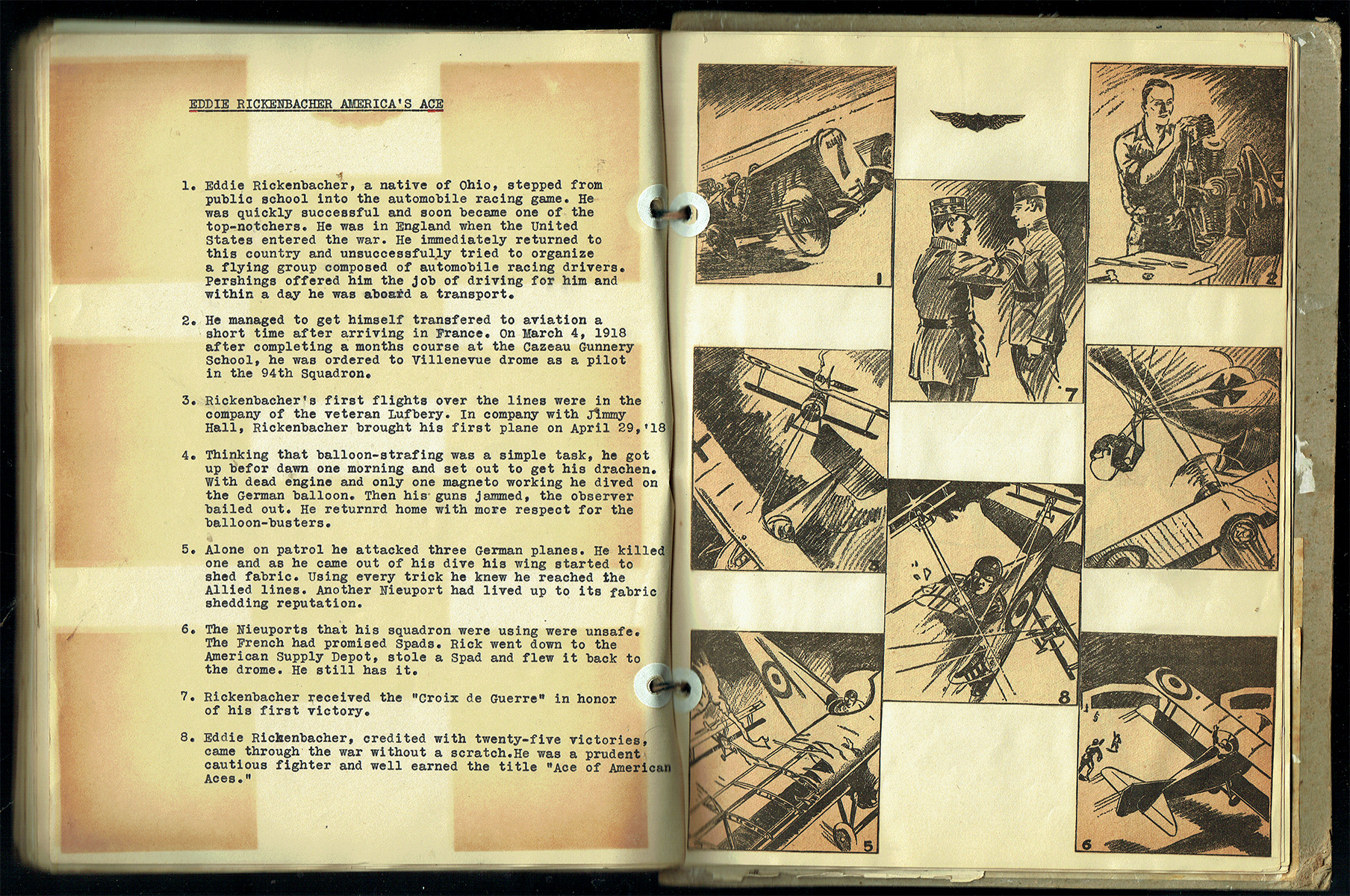
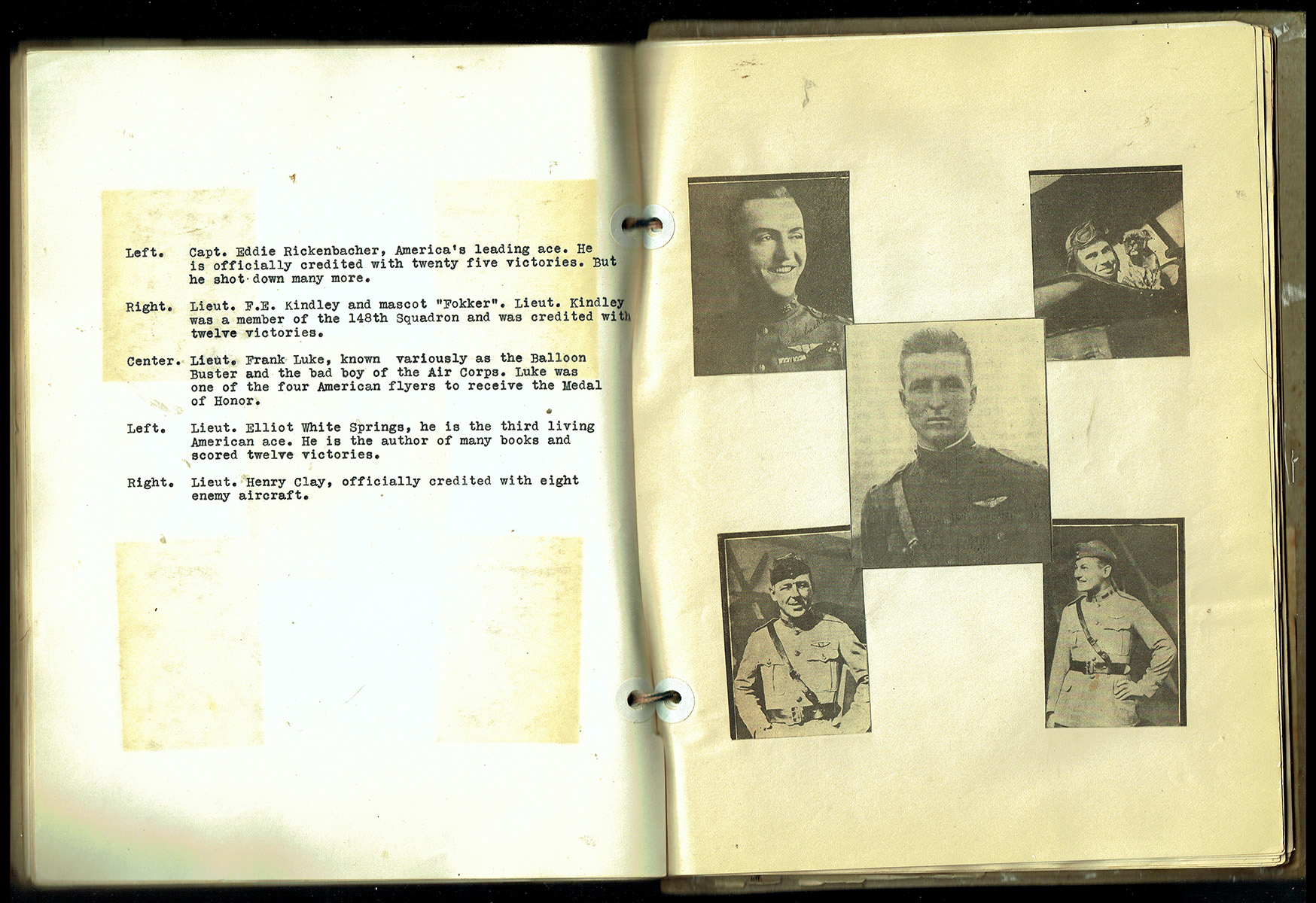
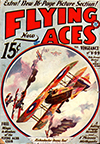
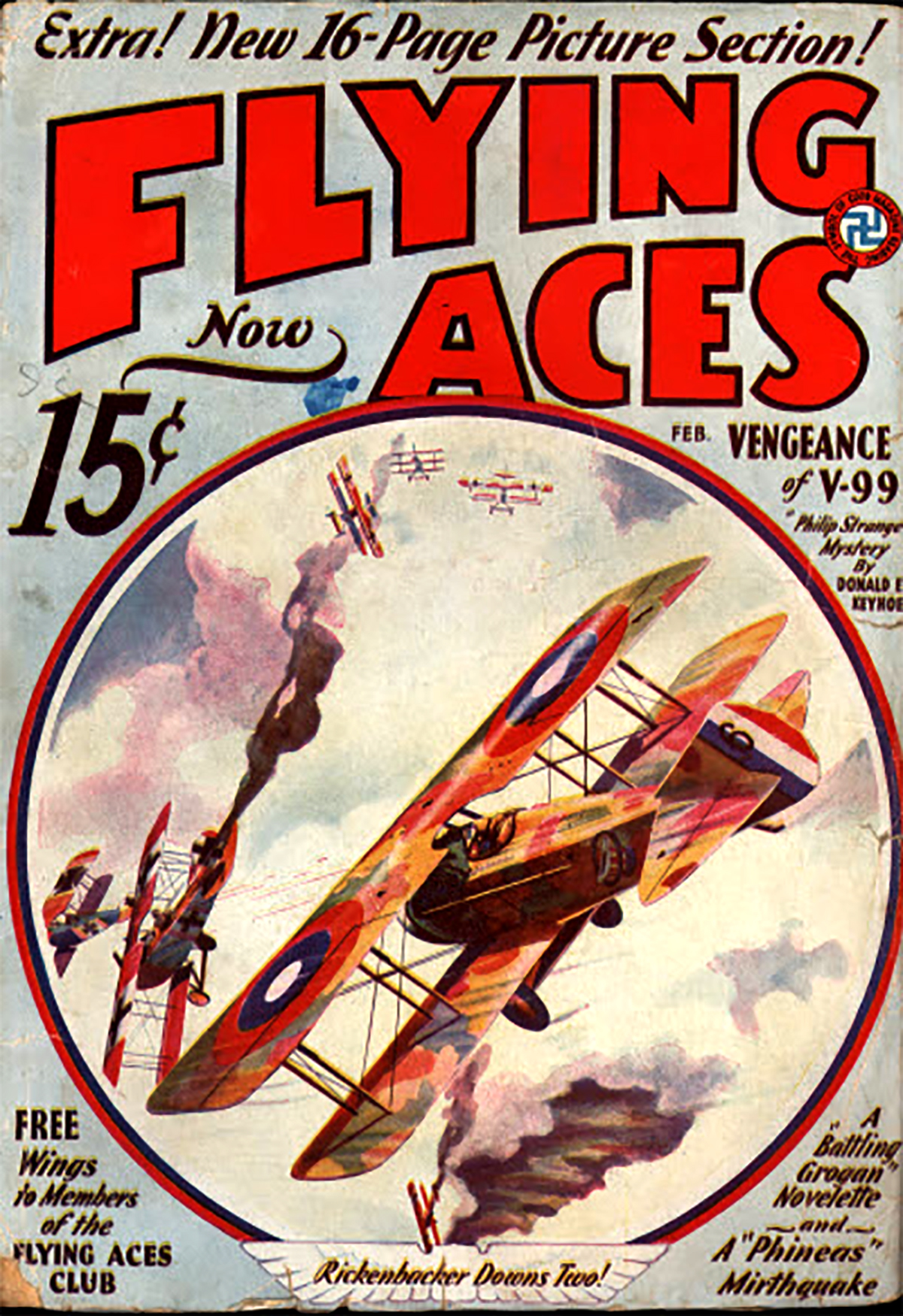
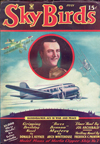


 THIS is the story of Lieutenant Wilbert White, of the 147th Pursuit Squadron. It is the story of his last flight. Whitey died on the last flight—he dove head-on into a Fokker to save the life of a youngster whom he had promised to protect on the youth’s first flight over the lines.
THIS is the story of Lieutenant Wilbert White, of the 147th Pursuit Squadron. It is the story of his last flight. Whitey died on the last flight—he dove head-on into a Fokker to save the life of a youngster whom he had promised to protect on the youth’s first flight over the lines.


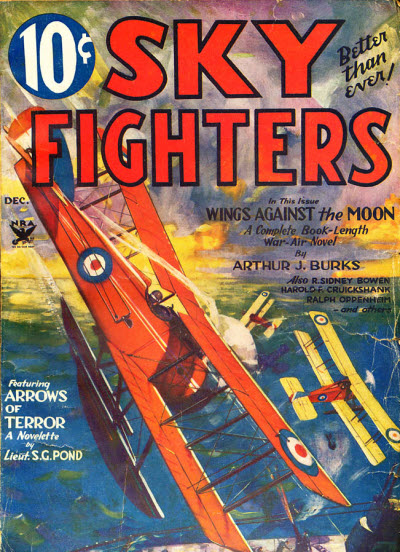 great story from the pen of Ralph Oppenheim. Best known in these parts for
great story from the pen of Ralph Oppenheim. Best known in these parts for 

